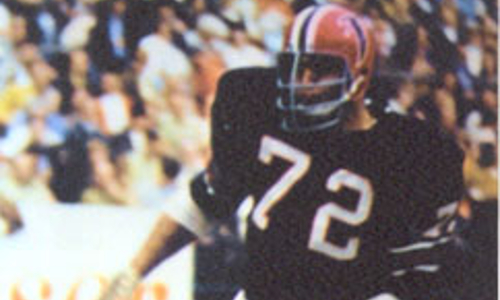Greg Lens’ large stature and Midwest roots earned him the nickname “Minnesota Monster.” Lens was a talented football player who played defensive line for Trinity University in San Antonio. Lens was drafted by the St. Louis Cardinals in the 1970 NFL draft and played two seasons for them before playing in the World Football league for the New York Stars and Charlotte Hornets. Eight years before his death, he began to show symptoms as he became reserved and started having memory problems, speech problems, and hallucinations. Lens spent the last years of his life in nursing homes. After his death, his family donated his brain to the UNITE Brain Bank where researchers diagnosed him with stage 4 (of 4) Chronic Traumatic Encephalopathy (CTE).

CTE and what it means to me
Chronic Traumatic Encephalopathy is a progressive degenerative disease of the brain found in people with a history of repetitive brain trauma.
I chose to do my project on CTE because my grandfather, who played in the National Football League as well as the World Football League, suffered from and died with this horrible disease. With all of the recent attention and awareness around sports related concussions, I really wanted to learn more and see what I could do to educate myself, others and raise my own awareness.
It was important for me to really understand how my grandfather was affected by CTE. When I was five years old, I remember telling him that when I grew up I wanted to be a football player just like he was. He kind of laughed but then told me that I should stick with games like golf and tennis. He said those are two sports that you can play your whole life and your body won’t take a beating like it does in football. Then he told me that football just wasn’t worth it. I still really like watching football and I still wanted to play too. But I just have to think, is it really worth it? I am still at risk though, because I play soccer. CTE does not only affect football players, all athletes take chances when playing sports.
In order to protect myself, I choose to learn more. How can I prevent this from happening to me? In order to help others, I choose to talk about what I learn. How can I help to keep my teammates and friends safer?
I think what’s really interesting about my project on CTE and sports related concussion research is that it’s new information that can change the way that we play dangerous games. Rules are changing and concussions are getting way more attention than back when my grandfather played. Back then they were just told to go right back in and play. Now players are looked over on the sidelines before deciding if they can go back in. This topic has personally affected my family which also makes it interesting to me.
Most of the research that I put into my project had to do with signs of CTE and how it can be caused. I also mentioned the team at the Concussion Legacy Foundation and Boston University. They are who I learned from the most. Chris Nowinski, the founder of CLF has written a book and now a movies has been made from it. It’s called Head Games.
The research that’s been done is great. On their site I found 7 steps for brain safety. I thought this was very easy to follow and very important in making a difference.
CTE 7 steps for Brain Safety:
CTE is preventable with a few steps
1.Preseason education for athletes
2. Preseason education for coaches
3. Preseason education for parents
4. CDC Concussion Action Plan:
- Remove athlete from play.
- Ensure athlete is evaluated by an appropriate healthcare professional. DON’T JUDGE IT YOURSELF.
- Inform athletes’ parent or guardian.
- Allow athlete to return to play with a health care professionals’ approval.
5. Utilize CDC Heads up Program and clipboard sticker.
6. Prevention through neck strengthening.
7. Prevention through overall Brain Trauma.
I really hope that I have helped you to understand the brain disease known as CTE, a little more. With these 7 steps as a start and a guide, I feel like we can be on our way to safer competitive sports.

